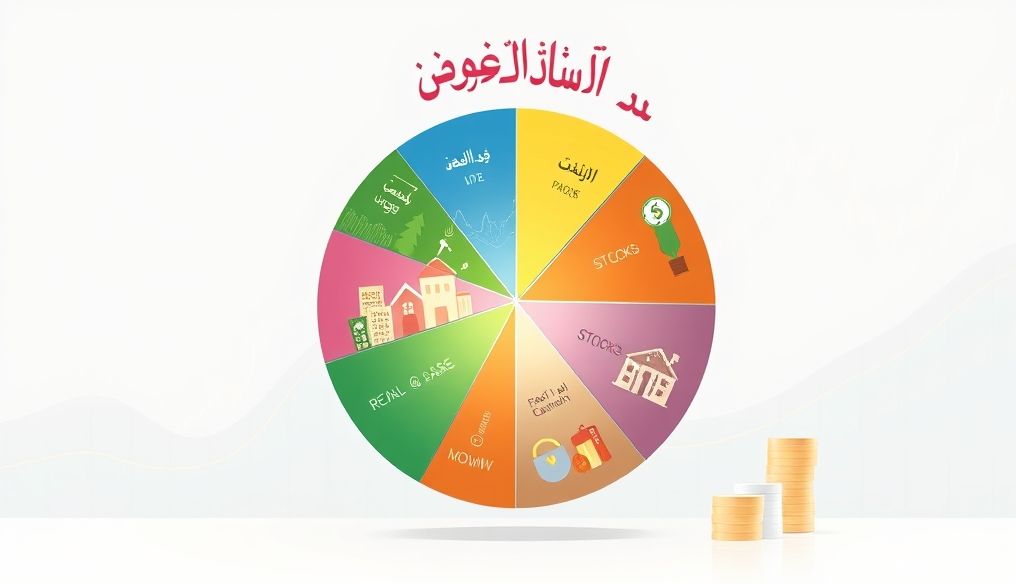Introduction: Why You Need a Diversified Investment Portfolio
In the world of finance and investing, building a diversified and balanced investment portfolio is the cornerstone of achieving long-term financial goals and mitigating risk. For the Arab investor, who may face specific challenges related to local markets and economic fluctuations, understanding the principles of diversification and balance becomes even more crucial.
Diversification means spreading your investments across a variety of assets, such as stocks, bonds, real estate, and commodities, while balance aims to maintain the optimal asset allocation based on your risk tolerance and investment objectives.
Chapter 1: Understanding Your Investment Goals and Risk Tolerance
Before you start building your investment portfolio, it is essential to clearly define your investment goals. Are you saving for retirement? Do you want to buy a house? Are you seeking to generate additional income? Defining your goals will help you determine the time frame for your investments and the appropriate level of risk.
Assessing Your Risk Tolerance
Your risk tolerance is a crucial factor in determining the appropriate asset allocation. Are you willing to withstand significant fluctuations in the value of your investments in exchange for higher returns? Or do you prefer to preserve capital even if the returns are lower?
- Conservative Investor: Prefers low-risk investments such as government bonds and money market funds.
- Moderate Investor: Seeks a balance between risk and return, investing in a mix of stocks and bonds.
- Aggressive Investor: Willing to take high risks to achieve high returns, investing heavily in stocks and emerging markets.
Chapter 2: Types of Investment Assets Available in the Arab Market
A variety of investment assets are available in the Arab market, each with its own characteristics in terms of risk and return.
Stocks
Stocks represent ownership shares in companies and are considered one of the most profitable investment assets in the long run. However, they are also the most volatile, as their value is affected by the financial performance of companies and general economic conditions.
Bonds
Bonds represent loans you make to the issuer (government or companies) and are considered less risky than stocks. Bonds pay a fixed interest rate over a specified period and are a good option for conservative investors.
Real Estate
Real estate is a tangible investment that can provide rental income and long-term appreciation. However, real estate requires significant capital and maintenance and management costs.
Commodities
Commodities include precious metals (gold and silver), oil, and agricultural products. Commodities can be a way to hedge against inflation and diversify the investment portfolio.
Exchange-Traded Funds (ETFs)
Exchange-traded funds provide an easy and low-cost way to invest in a variety of assets. These funds track specific market indices, such as the Saudi Stock Exchange Index (TASI) or the Dubai Financial Market Index.
Chapter 3: Asset Allocation: Building a Balanced Portfolio
Asset allocation is the process of determining the percentage that should be allocated to each type of asset in your investment portfolio. The optimal allocation depends on your investment goals and risk tolerance.
Example:
| Investor Type | Stocks | Bonds | Real Estate | Commodities |
|---|---|---|---|---|
| Conservative | 20% | 60% | 10% | 10% |
| Moderate | 50% | 30% | 10% | 10% |
| Aggressive | 80% | 10% | 5% | 5% |
Chapter 4: Choosing the Right Investment Instruments
Once you have determined the asset allocation, you must choose the appropriate investment instruments to implement your strategy. This may include choosing individual stocks, mutual funds, or exchange-traded funds.
Tips for Choosing Individual Stocks:
- Look for companies with strong financial performance and good management.
- Focus on companies you understand well.
- Diversify your investments in several different companies.
Tips for Choosing Mutual Funds and Exchange-Traded Funds:
- Compare fees and expenses.
- Look for funds with good long-term performance.
- Choose funds that align with your investment goals.
Chapter 5: Periodic Portfolio Rebalancing
Over time, the percentages of asset allocation in your portfolio may change due to changes in the value of different assets. It is essential to rebalance the portfolio periodically to maintain the optimal asset allocation.
Example: If your portfolio originally consisted of 50% stocks and 50% bonds, and the value of stocks increased significantly, the stock ratio may become 70% and the bond ratio 30%. In this case, you should sell some stocks and buy some bonds to rebalance to 50/50.
Chapter 6: Investing in Emerging Markets in the Arab Region
Emerging markets in the Arab region offer significant investment opportunities, but they also carry higher risks. Investors should conduct thorough research before investing in these markets and understand the political and economic factors that affect them.
Tips for Investing in Emerging Markets:
- Start with a small amount of money.
- Diversify your investments in several different markets.
- Invest for the long term.
Chapter 7: The Role of a Financial Advisor in Building a Portfolio
If you are unsure how to build an investment portfolio that is right for you, it may be helpful to consult a financial advisor. A financial advisor can help you define your investment goals, assess your risk tolerance, and choose the appropriate investment instruments.
Chapter 8: Taxes and Legal Considerations in Investing
Arab investors should be aware of the taxes and legal considerations related to investing in their countries. Tax laws can vary significantly from country to country, and it is important to obtain specialized legal and financial advice to ensure compliance.
Chapter 9: Monitoring and Evaluating Portfolio Performance
Once you have built your investment portfolio, it is important to monitor and evaluate its performance regularly. Compare the performance of your portfolio to the performance of benchmark market indices and ensure that it is achieving your investment goals.
Chapter 10: Additional Tips for the Arab Investor
- Continuous Education: Stay up-to-date with financial and economic market news.
- Patience: Investing is a long-term game, and don't expect quick profits.
- Avoid Making Emotional Decisions: Don't let fear or greed influence your investment decisions.
- Geographic Diversification: Consider investing in global markets to reduce risk.
- Leverage Technology: Use the available digital tools and platforms to facilitate the management of your investments.
Disclaimer: This article is for informational purposes only and does not constitute financial advice. You should consult with a qualified financial advisor before making any investment decisions.




